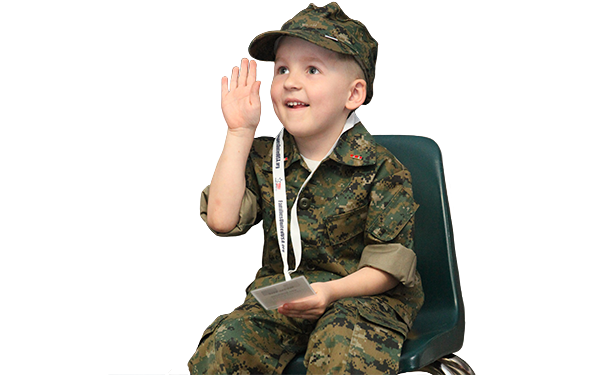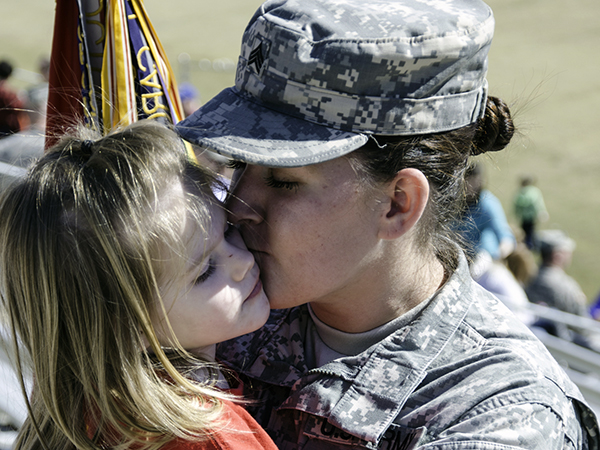Families Eager But States May Not be Ready for New ESSA Rule on Tracking Military Students

Jan Iwase, principal of Daniel K. Inouye Elementary School on the biggest military base in Hawaii, has seen her brightest students turn anxious and withdrawn as their parents leave for deployments overseas — sometimes two or three times in a row.
An “A” student dropped to Bs or Cs at the prospect of yet another move in the middle of the school year, Iwase recalled. And, of course, the most devastating possibility — a parent’s death in the line of duty — looms over the nearly 800 military-connected students who attend her school. In Hawaii, 30 percent of the student population is tied to the armed services.
Educators like Iwase witness the often-heartbreaking realities of those students’ lives on a daily basis. Meeting their unique needs in the classroom can be a challenge, she told The 74. Students typically enroll at Daniel K. Inouye, a military transition school, for two to four years — but sometimes they only stay a few days, while their families wait to be assigned to permanent housing elsewhere.
“To me, it’s amazing that some of these kids are as successful as they have been with all the changes in their lives,” Iwase said.
Exactly how military life — especially during the extended conflicts in the Middle East — affects the academic health of the more than 1.8 million children whose parents are U.S. service members is difficult to suss out because reliable national data has been virtually nonexistent.
That’s about to change — and state education officials, some of whom are unaware of the pending mandate, should take notice, along with education researchers who will now have a rich new data source.
Buried in the 400-page-plus Every Student Succeeds Act, the new K-12 federal education law, is a little-known “military-student identifier” provision requiring states to identify these students and track their test scores, attendance and graduation rates. For the first time, the academic outcomes of military students will be singled out the same way as those of other vulnerable “subgroups” — students who are followed because of their socioeconomic status, race, ethnicity, disability, English language proficiency and gender.
“We always felt like it made sense that the military lifestyle might have an impact on a child’s academic achievement,” said Eileen Huck, government relations deputy director at the National Military Families Association. “The problem is, there is no data out there to show us how military kids are doing in school, and without that data, it’s hard to make policy recommendations or direct resources effectively.”


Photo: National Military Families Association
Ultimately, the provision will produce that new national data set that could provide educators, parents and policymakers with valuable information about how military-connected students are performing in comparison to their peers, advocates say.
Huck, who has two children in high school and whose husband is an active-duty member of the Navy, knows from 20 years of experience how frequent moves during a child’s school career can strain grades and relationships with classmates and teachers.
“There’s a misapprehension I think, that all military families live on bases and they’re just surrounded by other military families — and in some instances that’s the case, but the majority are out living in civilian communities and are sending their kids to local public schools,” Huck said. “Teachers and administrators don’t always know to ask if it’s a military family or if there’s a military connection, or if they do know, they don’t understand the effect that a deployment, for example, can have on a kid’s state of mind.”
States may not know what’s coming
At the Indian River Central School District in upstate New York, about 65 percent of the 4,000 students are from military families, with most stationed at nearby Fort Drum. While the district already carefully counts on-base and off-base students for federal financial aid purposes, it doesn’t follow their academic outcomes.
Tweaking the system to do so would be fairly simple, at least in the case of his district, said business administrator Jim Koch, a veteran with three grown children of his own who went through the public schools.
“There was just dead silence…because they had no idea this (provision) existed”
Getting state education officials up to speed — while they’re also preparing to work out the many other changes ESSA will usher in — is critical, Koch said.
As a commissioner on the New York State Interstate Compact for the Education of the Military Child, Koch traveled to Albany in late April to discuss this and other issues. The response from state education representatives was telling, he said.
“There was just dead silence … because they had no idea this (provision) existed,” he said.
Mary Keller, president and CEO of the Military Child Education Coalition (MCEC), is among those who’ve lobbied lawmakers to recognize military students as a subgroup for years. A 2011 Government Accountability Office report recommended federal policymakers consider the change.
“It’s malpractice, essentially,” Keller said, to be capable of collecting such data — like states and the federal government do for other student subgroups — and not also apply it to better understand the strengths and weaknesses of military students.
The majority, or 56 percent, of the children of service members (including active duty, National Guard and Reserve members) are school age, between 6 and 18 years old, according to the 2014 Department of Defense military demographics report. Most of them attend U.S. public schools, the Military Child Education Coalition says.
Left out by Lyndon Johnson
The absence of reliable data on military students’ collective academic performance can be traced back to the 1965 passage of the Elementary and Secondary Education Act under President Lyndon B. Johnson, Keller said. That law initially classified students in demographic “subgroups,” primarily based on economic status, for the purpose of distributing federal aid to the most needy. The children of soldiers weren’t thought of as a subgroup back then.
Keller said the organization has for years pursued state-by-state efforts to get education officials to include military students as a subgroup in their electronic data systems and keep track of their fate in school.
The effort has been somewhat successful, with roughly 13 states currently flagging military students in their education data systems, according to the Virginia Department of Education, which tallied legislation and independent policies in a 2014 report.
By Keller’s count, the current number is a little higher, between 15 and 19.
But the state-by-state data doesn’t necessarily go deep — Florida, for one, simply counts the number of military students in its system. The Department of Education said military student-specific data like test scores and graduation rates weren’t readily available, but offered to gather it upon request.
North Carolina began flagging military children — based on families who self-identified — in its student-information system in fall 2015, so principals and teachers could know a little more about who their students are and what emotional baggage they might be carrying to school.
“There was an interest in making sure our districts were military friendly,” said Vanessa Jeter, spokeswoman for the state Department of Public Instruction. Academic outcomes for military students as a distinct group aren’t yet available in North Carolina, she said.
“States have been making progress over the last few years but this (federal provision) will really broaden the impact,” said Jennifer Thomsen, a research manager for the Education Commission of the States.
If the data shows that military-connected students are performing just as well as their non-military connected peers, then that’s reassuring, she said.
“On the flip side, if military-connected students are lagging behind, then you can say clearly, there are some additional supports that are needed in this school,” Thomsen said.
Keller said she anticipates being able to show policymakers less anecdotal and “more intentional” data that will lead to better and more efficient services for them, such as targeted academic help and mental health counseling.
For now, states and school districts are in a holding pattern while they wait for guidance from federal officials on how to implement this part of the law. The Department of Education has begun to issue ESSA guidelines and states are expected to roll out the changes in the 2017-18 school year but there is already contention over how the federal government is defining some of the new rules.
Math potential weak spot
Keller anticipates that a “robust” data set won’t be available before the 2019-20 school year.
When it is available, it’s expected to be collected by the National Center for Education Statistics, she said.
When it is eventually included on district and state report cards, it’s unlikely that data will be broken down by subgroups, like race and gender, within the military student subgroup. States may but are not required to provide the breakdown on their report card, a U.S. Department of Education spokesman said.
The data set also won’t include the roughly 74,000 students who attend Department of Defense schools scattered throughout the Americas, Europe and the Pacific, the spokesman said. These government-run schools are for children of active duty servicemembers and DOD civilian families but are entirely under the purview of the defense department, not state or federal education departments.
And what might this fresh military-related data from the nation’s public schools reveal?
Keller said she expects to find that these students generally are struggling with math after fourth grade because of the sequential nature of the subject. She also won’t be surprised — based on her 21 years of experience as a school administrator in Texas — to see evidence that military students in many cases are choosing lives of service outside of the military — as Peace Corps volunteers, clergy members and teachers.
Huck, of the National Military Families Association, said that a long-term focus on military students’ education will lead to better policy decisions that affect their lives into adulthood.
And, who knows, she added, “we may be reassured to see that military kids as a group are doing just fine.”
Students and the Military: What We Don't Know

Get stories like these delivered straight to your inbox. Sign up for The 74 Newsletter

;)
